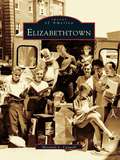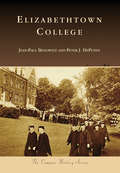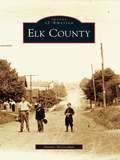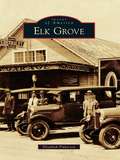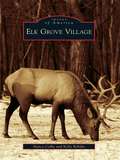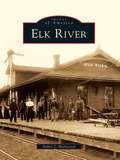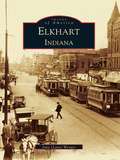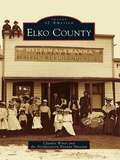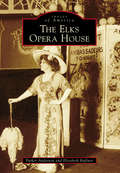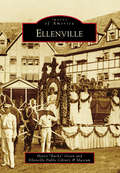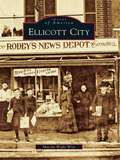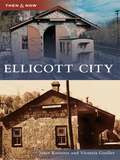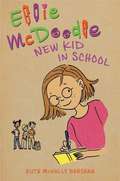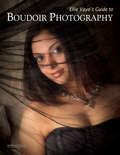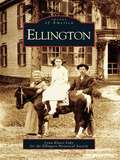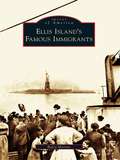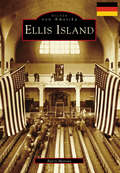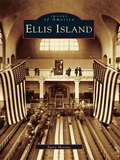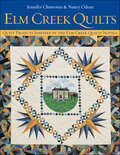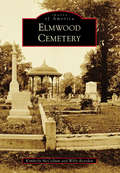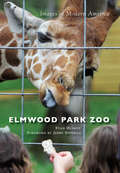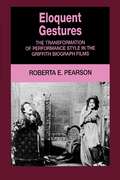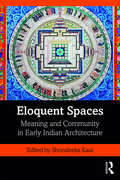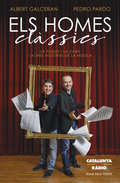- Table View
- List View
Elizabethtown (Images of America)
by Meranda L. CaswellIn the 1850s, Elizabethtown flourished due to the traffic from the Louisville & Nashville Railroad and Turnpike. Over the next decades, the community grew in size and population, evolving into the romantic travel destination and quaint hometown that it is now. Today, visitors tour Elizabethtown to immerse themselves in historical significance: the Schmidt's Museum of Coca-Cola Memorabilia, President Abraham Lincoln's heritage, Gen. George Armstrong Custer's stay before his last stand, Gen. John Hunt Morgan's raids during the Civil War, and Philip Arnold's western adventures. The Brown-Pusey House, built around 1825, is open to the public. Couples continue to marry in this historic boarding house and its formal garden.
Elizabethtown College (Campus History)
by Jean-Paul Benowitz Peter J. DepuydtEstablished in 1899 as an academy with a college preparatory curriculum for high school students of the Church of the Brethren, Elizabethtown College evolved into a fully accredited, four-year, private liberal arts institution. Located in the heart of Lancaster County, Pennsylvania's largest community of Amish, Mennonites, and Church of the Brethren, Elizabethtown College is home to the internationally recognized Young Center for Anabaptist and Pietist Studies. Known for its heritage of being founded by one of the Historic Peace Churches, Elizabethtown College hosts the Center for Global Understanding and Peacemaking. Today, the college is an independent residential academic community representing a wide variety of religious and philosophical perspectives firmly rooted in its commitment to servant leadership, peace, and justice.
Elk County
by Dennis McgeehanElk County, located in the scenic Allegheny Mountains of north-central Pennsylvania, is named and known for the wild, free-roaming elk herd that has become a valuable source of tourism. Sportsmen are attracted to this hunting and fishing paradise, which includes the Allegheny National Forest and the headwaters of the Susquehanna River system. Camping and canoeing entice visitors to the natural beauty of this wilderness setting. Elk County is a worldleader in the fields of carbon and powdered metallurgy. A modern paper mill enriches the local economy, and thousands of people each year visit the Chainsaw Carvers Rendezvous, which is part of theLumber Heritage Region of Pennsylvania. The historic photographs featured in Elk County illustrate the industry, character, and faith of the county's residents from pioneer spirit to present progress through the wealth of its vibrant and enduring communities.
Elk Grove
by Elizabeth PinkersonElk Grove's roots go back to 1850, when the community consisted of only a stage-stop hotel. In 1876, this small farm town in the shadow of Sacramento became a crossroads along the new railroad tracks. As the railroad era progressed, it brought significant changes to Elk Grove--fields were transformed into orchards, vineyards, and eventually, residential developments. But Elk Grove remained just a part of southern Sacramento County until citizens prevailed in their attempt to establish cityhood. The city was formally incorporated on July 1, 2000, with 72,665 residents and, by 2006, had grown remarkably to exceed 130,874.
Elk Grove Village (Images of America)
by Kelly Behnke Nancy ColbyPrior to 1956, the area now known as Elk Grove Village was a massive cornfield. On July 17, 1956, Elk Grove Village was incorporated as a village, with a population of 116. Since that time, the growth of the village can only be described as phenomenal. Over 50 years, the village has dramatically changed since those early days of cornfields. The name Elk Grove Village was adopted from the great number of elk that roamed through the fenced-in portion of Busse Woods, along Arlington Heights Road, south of the Northwest Tollway. American Indians called the region Wapiti, meaning "elk."
Elk River
by Debra J. MortensenFur trade posts were established along the Upper Mississippi River between St. Anthony and St. Cloud during the first part of the 19th century. One of these trading posts was established by Pierre Bottineau on the bluffs just north of the mouth of the Elk River between Orono (upper town) and Elk River (lower town) in 1850. As the fur trade slowed, the logging industry took over and numerous sawmills sprung up along the rivers. Ard Godfrey, well known in the milling industry, established the first mill in Orono in 1851. As the township of Elk River grew, the population jumped from 7 people in 1849 to 134 in 1857. Ponds and gullies were drained and filled to make room for more businesses. In Elk River, learn about the Civil War soldiers, the dynamiting of the Blind Pig Saloon, the murder of Deputy Sheriff Ed Foley, devastating fires, and the Boxcar Murder, told through pictures and newspaper clippings.
Elkhart Indiana
by Amy Lant WengerSome 200 years ago, when the Potawatomi Indians were still among the region's primary inhabitants, there was a winding river that was christened "Coeur de Cerf"-the heart of a stag. Legend has it that the earliest settlers were captivated by a small island that resembled an elk's heart. By 1832, Havilah Beardsley began to lay the foundation for what would soon be known as the village of Elkhart. The little island which inspired the Elkhart name would later be called "Island Park." There were only a few dozen lots in that first plat, but by 1858, Elkhart was incorporated as a growing and bustling new city. Today, Elkhart is recognized as being one of northern Indiana's most enterprising communities, as well as one of the most culturally diverse. Throughout its long and illustrious history, Elkhart has been blessed with a celebration of successes, in fields ranging from musical instruments to pharmaceuticals to recreational vehicles. The images in this book offer a glimpse into the events that helped shape Elkhart into the marvelous city it has become, truly, the "city with a heart" in both name and spirit.
Elko County
by Northeastern Nevada Museum Claudia WinesElko County, located in the northeast corner of Nevada, is the fourth largest county in the continental United States. Miles and miles of sagebrush give way to scenic spots, such as Lamoille Canyon and the Ruby Mountains, and locals are proud of this ruggedly beautiful land. Although the county's area is vast, there are only 2.5 people per square mile, and almost 90 percent of the land is owned by the federal government. The major towns in Elko County were established in the late 1860s, when the railroad arrived and brought ranching and mining jobs to the area. In the 1930s, Elko County began attracting big-name entertainment and also became a destination for gaming, and those traditions continue today. With its rich heritage and unique, high-desert landscapes, Elko County is considered one of the last frontiers of the Old West.
Elks Opera House, The (Images of America)
by Parker Anderson Elisabeth RuffnerFor over 100 years, the Elks Opera House has been a landmark of the cultural scene in Prescott, Arizona, and the western United States. In 1904, the people of Prescott raised $15,000 toward a performance hall to be included in the Elks Building. The original structure featured opera boxes that were later removed to adapt to the demands of motion pictures, and the entire proscenium arch was covered with wood paneling. In 2010, the Elks Opera House Foundation completed major renovations to restore the original 1905 grandeur of the theater and the 1928 marquee, which was paid for by grants from local charitable foundations, Arizona historic preservation funds, and generous participation by businesses and individuals. The Elks Building was listed in the National Register of Historic Places in 1978.
Ellenville
by Ellenville Public Library & Museum Henry Bucky" GreenSurrounded by the beautiful Shawangunk Mountains, Ellenville, New York, is a gateway between the Catskills, the Hudson River Valley, and New York City. Its people and places are what make Ellenville special. Artists, laborers, entrepreneurs, and national figures are among Ellenville's citizens. Its architectural gems include the Ellenville Post Office and Hunt Memorial Building, located in the heart of the village on Liberty Square; both are in the National Register of Historic Places. The original site of the Ulster County Fair, Ellenville has been home to vital American industries. The Delaware & Hudson Canal and early railways gave rise to tanneries, glassworks, a production pottery, and a knife manufactory. Resorts, boardinghouses, and inns welcomed travelers along some of the nation's oldest roads. Originating over 200 years ago as Fairchild City, Ellenville retains its small-town character to this day.
Ellicott City
by Marsha Wight WiseEllicott City, the seat of Howard County, began its life as a mill town before the American Revolution. Quaker brothers Joseph, Andrew, and John Ellicott built their first mill in 1772. The Patapsco Valley and River provided the brothers with the fertile land and power necessary to make the finest wheat flour. Ellicotts Mills, as the town was first known, grew steadily, becoming home to mill workers and merchants. Maryland founding families such as the Carrolls, Dorseys, and Warfields kept their family fortunes in Ellicott City because of the brothers' agricultural expertise. Thus a town rich in history, tradition, and architectural gems was born. Highlighted in Images of America: Ellicott City are many long-gone local landmarks, including the Patapsco Female Institute and Rock Hill and St. Charles Colleges. Featured as well are the monuments to bygone days that have endured time, progress, floods, and fires, and are still standing today.
Ellicott City: Tales From The Patapsco River Valley (Then and Now)
by Victoria Goeller Janet KustererIn 1772, the Ellicott brothers purchased land and water rights in the valley along the banks of the Patapsco River for $3 an acre. They constructed mills, started the National Road, and brought the railroad to what was then called Ellicott's Mills.
Ellie McDoodle: New Kid in School
by Ruth BarshawEllie writes and doodles in a journal of her family's move to a new home and her struggle to make friends, which gets a lot easier as leads a nonviolent protest of long lunch lines at school.
Ellie Vayo's Guide to Boudoir Photography
by Ellie VayoThe secrets of boudoir photography#151;such as attracting clientele, setting the right mood, shooting flawless hair and gorgeous make-up, and adding subtle sex appeal#151;are revealed in this illustrated guide for professional photographers. The reference provides the essential steps for adding this service, as well as case studies of numerous real-life sessions. By implementing the tasteful marketing strategies and the elegant, classy style of image-making offered in this guide, photographers will vamp up not only their studio offerings but also their sales.
Ellington
by Ellington Historical Society Lynn Kloter FahyLocated 16 miles northeast of Hartford, Ellington was incorporated in 1786 and has retained the charm of a New England village and farming community. Originally part of Windsor, it was known as the Great Marsh. Ellington Center, with its town green and 18th- to 20th-century houses, is on the National Register of Historic Places. Japanese business pioneer Francis Hall donated the jewel of the district to his hometown in 1903--the neoclassical-revival-style library. Archival photographs preserve faded memories of schools, churches, townspeople, and a unique dentist's tooth-shaped tombstone. Ellington captures a time when John Hall's Ellington School was known worldwide, Crystal Lake was a popular summer resort, and Daniel Hallady invented the modern windmill.
Ellis Island's Famous Immigrants
by Barry MorenoSince 1776, millions of immigrants have landed at America's shores. To this day, their practical contributions are still felt in every field of endeavor, including agriculture, industry, and the service trades. But within the great immigrant waves there also came plucky and talented individualists, artists, and dreamers. Many of these exceptional folk went on to win worldly renown, and their names live on in history. Ellis Island's Famous Immigrants tells the story of some of the best known of these legendary characters and highlights their actual immigration experience at Ellis Island. Celebrities featured within its pages include such entrepreneurs as Max Factor, Charles Atlas, and "Chef Boyardee"; Hollywood icons Pola Negri, Bela Lugosi, and Bob Hope; spiritual figures Father Flanagan and Krishnamurti; authors Isaac Asimov and Kahlil Gibran; painters Arshile Gorky and Max Ernst; and sports figures Knute Rockne and Johnny Weissmuller.
Ellis Island: Official Ellis Island Souvenir Guide (Images of America)
by Barry MorenoThe United States is considered the world's foremost refuge for foreigners, and no place in the nation symbolizes this better than Ellis Island. Through Ellis Island's halls and corridors more than twelve million immigrants-of nearly every nationality and race-entered the country on their way to new experiences in North America. With an astonishing array of nineteenth- and twentieth-century photographs, Ellis Island leads the reader through the fascinating history of this small island in New York harbor from its pre-immigration days as one of the harbor's oyster islands to its spectacular years as the flagship station of the U.S. Bureau of Immigration to its current incarnation as the National Park Service's largest museum.
Ellis Island: Official Ellis Island Souvenir Guide (Images of America)
by Barry MorenoThe United States is considered the world's foremost refuge for foreigners, and no place in the nation symbolizes this better than Ellis Island.Through Ellis Island's halls and corridors more than twelve million immigrants-of nearly every nationality and race-entered the country on their way to new experiences in North America. With an astonishing array of nineteenth- and twentieth-century photographs, Ellis Island leads the reader through the fascinating history of this small island in New York harbor from its pre-immigration days as one of the harbor's oyster islands to its spectacular years as the flagship station of the U.S. Bureau of Immigration to its current incarnation as the National Park Service's largest museum.
Elm Creek Quilts: Quilt Projects Inspired by the Elm Creek Quilts Novels
by Jennifer Chiaverini Nancy Odom“The Quilter’s Apprentice” was just the beginning. Join Jennifer Chiaverini and Nancy Odom in creating quilts inspired by Jennifer’s best-selling Elm Creek Quilts novels. Now you can make the Elm Creek Medallion or any of a dozen designs inspired by beloved characters such as Sylvia, Sarah, Andrew, and Bonnie. • 12 quilt projects inspired by all 4 Elm Creek novels, ranging from Sarah’s Sampler and the Elm Creek Medallion to Sylvia’s Broken Star and the Runaway Quilt • Every quilt tells a story of its own, for both longtime fans and those just discovering the appeal of Elm Creek • Designs for all skill levels and styles presented in friendly Elm Creek fashion • Introduction by Jennifer Chiaverini - read about how the Elm Creek Quilts novels got started
Elmwood Cemetery (Images of America)
by Kimberly Mccollum Willy BeardenElmwood Cemetery was founded in August 1852 by 50 prominent Memphians who resolved to create a new burial site just two and a half miles outside the city limits. The name of the cemetery was drawn out of a hat by one of the founding fathers. A nurseryman from Scotland was hired to lay out the grounds, and Elmwood was opened to people from all backgrounds to use as their family cemetery. Elmwood has survived wars, military occupation, epidemic disease, and the bankruptcy and near collapse of Memphis, only to emerge as one of the premier outdoor museums in the United States. Its massive collection of Victorian memorial statuary is almost unrivaled, but Elmwood�s true allure lies in the stories of those who rest beneath the lush canopy of trees on its 80 acres. The graves at Elmwood belong to soldiers and statesmen, scoundrels and scalawags, writers and musicians, martyrs and madams, the notorious and the anointed, and so many more.
Elmwood Park Zoo (Images of Modern America)
by Jerry Spinelli Stan HuskeyElmwood Park Zoo was established in 1924 when roughly 16 acres of land and a small group of animals were donated to the borough of Norristown. Although the early years of the zoo were more akin to a small farm, it has gone through an extensive expansion during the past few decades. This expansion and the continued revitalization of Elmwood Park Zoo include some notable residents, such as the zoo's owl, who has become the mascot of Temple University, and its bald eagle, a sideline regular for the NFL's Philadelphia Eagles. The zoo today, with new features including a zip line and a giraffe exhibit, looks to the future, with plans for even more exhibits, a new restaurant, and an additional 20 acres yet to be developed.
Eloquent Gestures: The Transformation of Performance Style in the Griffith Biograph Films
by Roberta PearsonBetween 1908 and 1913, D. W. Griffith played a key role in the reformulating of film's narrative techniques, thus contributing to the creation of what we now think of as the classical Hollywood cinema. This book is the only extensive treatment of a critical period in the history of film acting: the emergence of the realistic "verisimilar" style in Griffith's biograph films. Roberta Pearson shows how Griffith gradually abandoned the deliberately affected "histrionic" acting style derived from the nineteenth-century stage. No longer did actors mime distress by raising their arms to heaven or clutching their heads—a subtle facial expression, a slight change in posture would convey a character's extreme emotions instead.Pearson makes detailed comparisons of certain Biograph films and brings a freshness to her analysis by closely examining contemporary journalistic writing, acting manuals, and the recollections of actors of the time. Her work is important for anyone interested in early cinema and performance, and it will enliven the study of American cultural history and mass communications.
Eloquent Images: Word and Image in the Age of New Media
by Mary E. Hocks Michelle R. KendrickThe emergence of New Media has stimulated debate about the power of the visual to dethrone the cultural prominence of textuality and print. Some scholars celebrate the proliferation of digital images, arguing that it suggests a return to a pictorial age when knowledge was communicated through images as well as through words. Others argue that the inherent conflict between texts and images creates a battleground between the feminized, seductive power of images and the masculine rationality of the printed word. Eloquent Imagessuggests that these debates misunderstand the dynamic interplay that has always existed between word and image. Arguing that the complex relationship between text and image in New Media does not represent a radical rupture from the past, the book examines rhetorical and cultural uses of word and image both historically and currently. It shows that complex, interpenetrating relationships between verbal and visual communication systems were already evident in hieroglyphic writing and in ancient rhetoric and persist in the work of classical rhetoricians, in cultural studies of technology, even in the binary code distinctions of digital environments. The essays blend theory, critique, and design practice to explore the often contradictory relations of word and image. All of them call for theoretically grounded approaches to hypermedia design.
Eloquent Spaces: Meaning and Community in Early Indian Architecture
by Shonaleeka KaulEloquent Spaces adopts the twin analytic of meaning and community to write a fresh history of building in early India. It presents a new perspective on the principles and practices of early Indian architecture. Defining it broadly over a range of space uses, the book argues for architecture as a form of cultural production as well as public consumption. Ten chapters by leading archaeologists, architects, historians and philosophers, examining different architectural sites and landscapes, including Sanchi, Moodabidri, Srinagar, Chidambaram, Patan, Konark, Basgo and Puri, demonstrate the need to look beyond the built form to its spirit, beyond aesthetics to cognition, and thereby to integrating architecture with its myriad living contexts. The volume captures some of the semantic diversity inherent in premodern Indian traditions of civic building, both sacred and secular, which were, however, unified in their insistence on enacting meaning and a transcendent validity over and above utility and beauty of form. The book is a quest for a culturally rooted architecture as an alternative to the growing crisis of disembededness that informs modern praxis. This volume will be of interest to scholars and practitioners of architecture, ancient Indian history, philosophy, art history and cultural studies.
Els homes clàssics: La Passió i la carn i altres històries de la música
by Albert Galceran Pedro PardoEl món ha de saber el que es perd si no coneix l'univers sonor que ofereixen els compositors a través de les seves obres. I és per això que pren sentit aquest llibre: per mirar d'explicar sense pretensions la història de la música a través de les vivències dels artistes que l'han protagonitzat. El xarlatà que va operar Bach i Händel i els va deixar cecs, el carnissser de Leipzig on comprava Mendelssohn, el triomf del valencià Martín i Soler a la cort de Caterina II de Rússia, l'anhel de llibertat de Beethoven, Rossini i els tenors, la vida amorosa de Wagner, els camins divergents de Ravel i Viñes o el fatídic viatge de Granados a bord del Sussex són algunes de les històries que se succeeixen en aquest viatge apassionant de Moscou a París, de la cort de Viena al teatre alla Scala de Milà, a través dels secrets i les anècdotes que han conformat quatre segles de música clàssica. Unes històries fascinants, divertides i que permeten descobrir -acompanyades de les reveladores audicions de Mozart, Beethoven, Rossini,Verdi, Liszt i Stravinski que proposen els autors- l'univers de la música clàssica. Pedro Pardo, músic de formació, i Albert Galceran, divulgador musical i periodista, tenen dues maneres de veure la música: mentre el Pedro té la capacitat d'analitzar-la des del seu interior, l'Albert la descobreix des de la perspectiva de l'oient i la posa en el seu context històric. Així doncs, dues maneres d'entendre un món, però una mateixa manera de viure'l: des de la passió. Ressenya:«Aquest llibre és una demostració més del que poden fer dos quan comparteixen una manera de veure la puresa de la vida. No us quedeu amb la música, quedeu-vos amb el que en el fons us expliquen.»Ricard Ustrell
